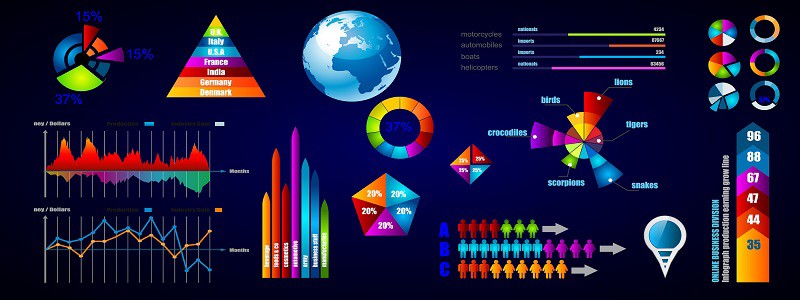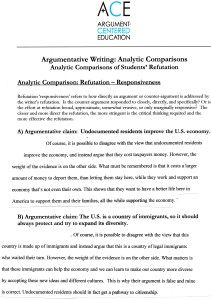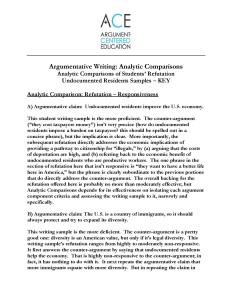
Analytic Comparisons Activity: Student Refutation Writing Samples
Overview
Students need to see models of argumentative writing to learn how to improve their own work. Those models should include some peer-student work that is proficient, but also some work that is deficient, so that students can see how certain criteria of effective argumentative writing are met and exceeded, and so that they can analyze the specific ways that argumentative writing can come up short.
Analytic Comparisons is an argumentative writing activity that enables students to think through both more effective and less effective examples of peer-student argumentative writing, helping them to self-reflect and incorporate this learning from close review of others’ work into the betterment of their own writing work.
The Analytic Comparisons activity can be done after collecting an argumentative writing assignment, as a way of creating a collective learning opportunity from the samples and patterns of student writing. It can also be done in advance of a writing project, if the instructor can draw on student writing from other classes or from earlier in the school year.
Analytic Comparisons: Refutation
Argument-Centered Education recently adapted the Analytic Comparisons activity with a partner school in a writing unit focused on the debatable issue:
Should the 11 million undocumented residents in the United States be given a pathway to citizenship?
You shouldn’t concern yourself much with this particular topic — it might be one of interest and use to you, it might not be. This activity hones in on argumentative writing skills and does so in a format and fashion that is adaptable across disciplines. You’ll be able to glean how this activity can be adapted by reviewing an example from a specific unit in an actual MS/HS classroom.
In this instance we drew from argument essays that were submitted, after the several-stage process of pre-writing and preparation in the unit. We wanted to draw from the completed writing samples to clearly explicate the skills of academic argumentation — those that are being mastered by students at this partner school and those that students are in the process of assimilating. We decided to focus on refutation — in particular, refutation of counter-arguments in an essay — so we used this skeletal version of the Analytic Comparisons Activity:
 Argument-Centered Education criteria for effective refutation structure the analytic comparisons that students are asked to make, closely reading and analyzing classmates’ work. Those four refutation criteria are standard throughout ACE resources and pedagogy.
Argument-Centered Education criteria for effective refutation structure the analytic comparisons that students are asked to make, closely reading and analyzing classmates’ work. Those four refutation criteria are standard throughout ACE resources and pedagogy.
Responsiveness
How directly an argument or counter-argument is addressed by the writer’s refutation. Is the counter-argument responded to closely, directly, and specifically? Or is the effort at refutation broad, approximate, somewhat evasive, or only marginally responsive? The closer and more direct the refutation, the more stringent is the critical thinking required and the more effective the refutation.
Comprehensiveness
The fullness and completeness of the refutation of the counter-argument. Does the effort at refutation leave a meaningful portion of the counter-argument standing, undermining the writer’s argumentative position? Or does the writer refute the competing argument or counter-argument fully and comprehensively, so that there is nothing left that materially contradicts or conflates the writer’s argumentative position?
Depth of Thinking
How thoughtful, acute, intellectually penetrating, and analytically reflective the refutation is. Does the writer’s refutation reflect serious, deliberate thoughtfulness and reflection? Or is it dismissive, superficial, surface-level, and too easy?
Strength of the Counter-Argument
Whether the writer engages with a credible, formidable counter-argument against the argument being made, or whether the writer sets up a ‘straw man’ to easily refute. A factor in determining a counter-argument’s strength is its specificity to the argumentative claim, as opposed to its addressing the overall position in the essay and not directly addressing the argument for that position.
We culled examples of more proficient and more deficient refutation among student writing samples on the undocumented residents issue and we created this adaptation of the activity.
 And I created this “answer key,” with analytics on each of the student writing samples under the four refutation criteria. The analytics identify the more proficient example of refutation relative to each criterion.
And I created this “answer key,” with analytics on each of the student writing samples under the four refutation criteria. The analytics identify the more proficient example of refutation relative to each criterion.
 A sample of our own analytics produced for the Key.
A sample of our own analytics produced for the Key.
Analytic Comparison: Refutation – Depth of Thinking
A) Argumentative claim: Deporting undocumented residents would tear apart millions of American families.
This writing sample is the more proficient. The counter-argument here is once again that U.S. governmental policy is justified in separating families, despite the harm that causes, because undocumented residents broke the law when entering the U.S. Refutation of this counter-argument entails only two short sentences. It’s short but sweet. The student focuses on the children in these families and argues that it wasn’t their decision to immigrate illegally, which means that it cannot be ethically just to implement a policy that harms (traumatizes, leaves parentless) these children living in the U.S. This is an example of carefully thinking through the full dimensions of the counter-argument, finding its most significant weakness, and honing the refutation on that. Like acute and insightful thinking generally, its simplicity reflects its depth of thought.
Students have worked in pairs to analyze the student writing samples on each of the four criteria for effective refutation, identifying which sample they believe is the more proficient and producing evidence-based reasoning that analyze the proficiencies and deficiencies of each writing sample. Pairs share out their views, as each refutation criterion is taken one by one. We of course have re-affirmed for students that all writing samples selected have some important strengths, and that anyone who recognizes their writing sample as one “more deficient” on a criterion should (a) be assured that it was from an essay doing well in certain areas, and (b) view this as a growth opportunity in a classroom in which we seek equivalent proportions of growth for every single student, regardless of the absolute level from which they start.
A Word on the Name
Argument-Centered Education calls this activity Analytic Comparisons in part to playfully reclaim the term “analytics” from the quantitative sciences. Aristotle first used the term “analytics” in an argumentational context in his treatise on deductive reasoning, Prior Analytics. There is a long history of use of the term “analytics” to signify discerning patters in objective reality (including text, as in textual analytics) to make truth-claims, rooted in the Greek term analutikos (“solutions”) and analuein (“to solve”). Analytics is too powerful a word to entirely cede, we think, to numbers-crunching in professional sports, earnings reporting, or political punditry or prognostication. Applying it the discovery of higher paths for our students in their academic writing seemed to us a justifiable re-appropriation.

